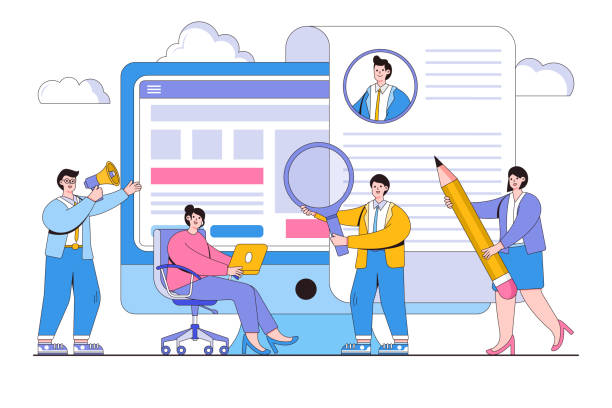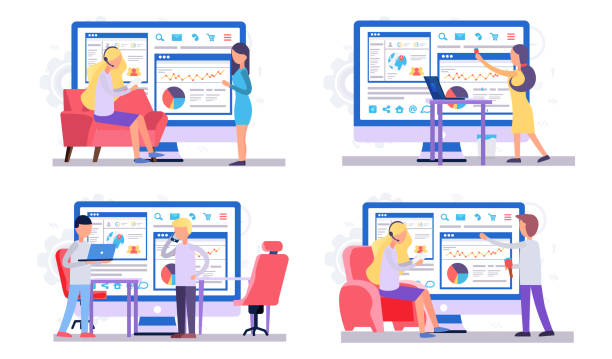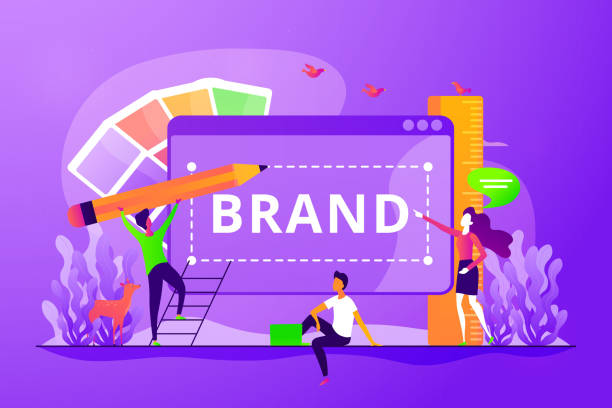The Importance of Fast Website Design in the Digital Age

In today’s world, where speed is paramount, fast website design is more than an advantage; it’s a vital necessity.
Internet users have high expectations for page loading speed, and even a few seconds of delay can lead to the loss of visitors.
This not only negatively impacts user experience (UX) but also directly affects search engine rankings and conversion rates.
Search Engine Optimization (SEO) is now heavily dependent on website performance, especially its loading speed.
Google and other search engines penalize slow websites and rank them lower, as their goal is to provide the best possible user experience.
Therefore, every business seeking online success must prioritize website speed optimization.
This process encompasses various aspects, from choosing suitable hosting to optimized coding and image compression.
#Website_Speed, #User_Experience, #SEO, and #Increased_Traffic are all direct results of fast website design.
We will delve into detail on how to achieve this goal and maximize its benefits for businesses.
This is an important educational step for anyone looking to improve their online presence and has explanatory and strategic aspects.
Are you tired of your company’s website not being seen as it deserves, losing potential customers? Solve this problem forever with professional and effective website design by Rasawweb!
✅ Increase brand credibility and gain customer trust
✅ Attract targeted sales leads
⚡ Contact us now for a free consultation!
Fundamental Principles in Website Speed Optimization

To achieve fast website design, several fundamental and specialized principles must be considered.
The first and perhaps most crucial step is choosing suitable hosting.
Quality hosting with powerful servers can minimize server response time.
Content Delivery Networks (CDNs) also significantly increase loading speed by storing your site’s content on servers close to users.
Next, code optimization becomes important.
Compressing HTML, CSS, and JavaScript codes, removing redundant code, and merging CSS and JS files to reduce HTTP requests are among the key actions.
Also, using CSS Sprites for small images and inlining critical CSS can help improve performance.
Images are one of the biggest factors slowing down a site.
Optimizing images by compressing them without significant quality loss and using modern formats like WebP is essential.
Also, implementing Lazy Loading for images and videos ensures that content is loaded only when the user scrolls to that part of the page, which itself helps accelerate initial loading.
Browser caching also makes subsequent visits much faster by storing static site files in the user’s temporary memory.
Reducing redirects and optimizing the use of plugins and external scripts are also important points in this regard.
These principles offer specialized and practical guidance for anyone looking to design a high-speed website.
Modern Tools and Technologies for Increasing Website Speed

For the fast website design process to proceed practically and effectively, understanding and utilizing modern tools and technologies is of paramount importance.
Speed testing tools like Google PageSpeed Insights, GTmetrix, and Lighthouse help you identify your site’s strengths and weaknesses in terms of performance.
These tools provide detailed reports and offer suggestions for improvement.
For instance, PageSpeed Insights provides scores for performance, accessibility, best practices, and SEO, and suggests items like “Eliminate render-blocking resources” or “Reduce JavaScript execution time,” which are technical aspects.
Alongside analytical tools, new technologies have also been developed that help speed up websites.
AMP (Accelerated Mobile Pages) enables instant loading for mobile pages, while PWA (Progressive Web Apps) provides a native-app-like experience in the browser, including offline capabilities and fast loading.
Using modern JavaScript frameworks like React, Vue.js, or Angular, which have internal performance optimizations, can also be effective in fast website design.
For image optimization, tools like ImageOptim or online image compression services play a vital role.
This section is educational and gives users a good overview of available solutions.
| Speed Test Tool | Key Features | Advantages |
|---|---|---|
| Google PageSpeed Insights | Mobile and desktop performance analysis, optimization suggestions | Integration with Google search engine, detailed guidance |
| GTmetrix | Comprehensive performance reports, YSlow and PageSpeed Score | Waterfall chart display, performance history |
| WebPageTest | Testing from different locations, various browsers, loading video capture | In-depth analysis, high customization options |
The Impact of User Interface and User Experience on Perceived Speed

In the discussion of fast website design, not only the actual page loading speed is important, but the user’s perception of speed is equally crucial.
User Interface (UI) and User Experience (UX) play a significant role in shaping this perception.
Even if a site is technically fast, but its loading process appears unpleasant to the user, the user might perceive it as slow.
This analytical section examines this aspect.
One of the most effective methods to improve the perception of speed is the use of Skeleton Screens.
Instead of displaying a blank page or a loading spinner, skeleton screens show the overall structure of the page before the content is fully loaded.
This gives the user a sense of progress and keeps them informed about the loading process.
Perceived Performance means designing a website in such a way that the user feels the site is faster than it actually is.
Visual feedback is also crucial in this area.
For example, displaying a simple animation or a temporary message when performing a time-consuming operation can prevent user frustration.
Fast website design involves attention to details that improve the user’s waiting experience.
This can include creative loaders, appropriate use of white space, and logical content organization.
Ultimately, the goal is that even when content takes a little longer to fully load, the user doesn’t feel their time has been wasted.
This explanatory and psychological approach is an inseparable part of a comprehensive strategy for website speed optimization.
Is your e-commerce site ready to attract maximum customers and increase sales? Rasawweb transforms your online business with modern and efficient e-commerce website designs.
✅ Increased speed and improved SEO
✅ Excellent user experience on mobile and desktop⚡ Get a free e-commerce website design consultation from Rasawweb!
The Role of Responsiveness and Mobile Design in Website Speed

In today’s world, where a significant portion of internet traffic comes from mobile devices, fast website design for mobile is not just an advantage but a necessity.
Responsive Design allows websites to adapt to the user’s screen size and provide an optimal user experience on any device.
However, responsiveness is only half the story; loading speed on mobile is even more critical than on desktop due to bandwidth limitations and processing power.
Google’s Mobile-First Indexing also emphasizes that Google considers the mobile version of your site as the primary version for ranking, so mobile speed optimization directly impacts SEO.
To achieve high speed on mobile, in addition to general optimization techniques, other specialized points must also be considered.
Using appropriately sized images for mobile devices (instead of high-quality images designed for desktop), removing heavy scripts or deferring their execution, and optimizing fonts are among the key measures.
Also, ensuring that all touchable elements (such as buttons and links) are sufficiently large and adequately spaced from each other helps improve user experience and perceived speed.
This section provides practical guidance for developers who are looking to deliver the best mobile experience and intend to prioritize mobile users in their fast website design process.
Caching Strategies and Content Delivery Networks (CDN)

One of the most powerful tools in the fast website design toolkit is the effective implementation of Caching strategies and the use of Content Delivery Networks (CDNs).
Caching means storing copies of your website’s content in a temporary location so that on subsequent visits, loading occurs faster.
This process can be implemented at various levels, each playing its role in increasing website speed.
Caching types include Browser Caching, which stores static files such as images, CSS, and JavaScript on the user’s device.
Server-side Caching includes Full Page Caching, Object Caching for databases, and Bytecode Caching for PHP codes.
This type of caching helps reduce server load and speed up its response.
Choosing the appropriate caching type depends on the website’s structure and needs, and this specialized section provides the necessary information.
Alongside caching, CDNs work by storing copies of your site’s static and sometimes dynamic content on servers dispersed in different geographical locations around the world.
When a user visits your website, the content is served from the CDN server closest to them, which significantly reduces physical distance and latency.
This is especially crucial for websites with international visitors.
Using a CDN along with strong caching strategies ensures a super-fast user experience and is a core pillar of fast website design.
This information is explanatory and highly practical.
Monitoring Performance and Troubleshooting Website Speed

Even after implementing all fast website design techniques, the optimization process doesn’t end.
Continuous monitoring of website performance and the ability to quickly troubleshoot potential issues are essential pillars for maintaining optimal speed and user experience.
Tools such as Google Analytics, Google Search Console, and browser developer tools (like Chrome DevTools) provide valuable information about site performance, resource consumption, and potential errors.
This section addresses technical and guidance aspects in this area.
To identify bottlenecks, several key factors must be considered.
Server Response Time can indicate hosting issues or server configuration problems.
Slow database loading, inefficient plugins, heavy external scripts, or unoptimized images can all act as speed-reducing factors.
By using Application Performance Monitoring (APM) tools like New Relic or Datadog, the performance of each part of the site can be thoroughly examined, and sources of slowness identified.
These monitors help you gain a deeper understanding of how the website behaves under different conditions and ultimately achieve sustainable fast website design.
Troubleshooting involves examining server logs, optimizing database queries, regularly updating plugins and themes, and removing redundant or unused code.
Sometimes, even a small change in code or server configuration can make a big difference in speed.
This analytical and technical approach is vital for maintaining your website’s competitiveness in the digital world and ensures that your site always remains in its best operational state.
| Common Speed Issue | Explanation | Suggested Solution |
|---|---|---|
| Unoptimized Images | High image size, inappropriate format, lack of compression | Compression, changing format to WebP, Lazy Loading |
| High Server Response Time | Weak hosting, improper server configuration, high traffic | Hosting upgrade, use of CDN, database optimization |
| Render-Blocking JavaScript and CSS | JavaScript and CSS files load before content | Minify and Combine files, Defer and Async JS, Inline critical CSS |
Future Trends in Optimization and Fast Website Design

With continuous advancements in web technology, the concept of fast website design is also constantly evolving.
In the future, we will witness the emergence and expansion of technologies that will push the boundaries of web speed and efficiency.
This section addresses the news and analytical aspects of future web speed optimization and also raises thought-provoking content.
One of the most significant developments is HTTP/3, built upon the QUIC protocol, which promises to significantly increase web loading speed by reducing latency and improving connection management.
This technology will be particularly efficient for mobile and unstable networks.
WebAssembly also allows developers to execute high-performance code directly in the browser, which can unprecedentedly increase the execution speed of complex web applications.
Will these technologies push web design towards more complex applications with flawless performance?
Also, Google’s focus on user-centric performance metrics (Core Web Vitals) indicates the increasing importance of actual user experience.
LCP (Largest Contentful Paint), FID (First Input Delay), and CLS (Cumulative Layout Shift) are metrics that directly affect users’ interactive and visual experience, guiding developers towards creating websites that not only load quickly but also convey a sense of speed and responsiveness to the user.
Will the traditional concept of speed optimization change with these new trends? Fast website design in the future will likely focus more on optimizing the user experience from the first moment of loading to full interaction with the page, rather than solely on reducing overall loading time.
Does your current site showcase your brand’s credibility as it should? Or does it scare away potential customers?
Rasawweb, with years of experience in designing professional corporate websites, is your comprehensive solution.
✅ A modern, beautiful website tailored to your brand identity
✅ Significant increase in lead generation and new customers
⚡ Contact Rasawweb now for a free corporate website design consultation!
Successful Examples of Fast Website Design

To better understand the concepts discussed regarding fast website design, examining successful examples of leading websites in this field can be very entertaining and at the same time educational.
These websites not only perform excellently in terms of loading speed but also provide a flawless user experience.
One of the most prominent examples is Google itself.
Google search pages load incredibly fast, and this speed is the foundation of the user experience for millions worldwide.
With extensive code optimizations, smart caching, and the use of widespread CDNs, Google showcases an unparalleled example of web speed.
Websites like Amazon, despite their high volume of content and products, have managed to provide acceptable speed through heavy investment in infrastructure and continuous optimizations, directly impacting their conversion rates and sales.
Wikipedia has also achieved remarkable speed with a simple, content-focused design.
By avoiding heavy scripts and focusing on text, this site demonstrates how fast website design can also be achieved with a minimalistic approach and content optimization.
High-traffic blogs and news sites also strive to maintain speed by using CDNs, advanced image compression, and ad optimization.
These examples are illustrative and show how large and small companies can achieve exceptional speed with the right strategies and maintain their competitiveness in the digital market.
Each of these examples is a clear instance of successful fast website design.
Conclusion and Continuous Website Speed Maintenance

As stated throughout this article, fast website design is not just a competitive advantage but a vital necessity for success in today’s digital landscape.
From improving user experience and increasing conversion rates to boosting search engine rankings and reducing bounce rates, all these factors depend on your website’s loading speed.
This section provides comprehensive guidance for summation.
The key point to always remember is that website speed optimization is not a one-time process but a continuous and ongoing effort.
Web technologies are changing, user behavior is evolving, and search engine algorithms are constantly being updated.
Therefore, to maintain a fast website design, you need continuous monitoring, updating, and optimization.
Regular performance audits, ensuring all plugins, themes, and the Content Management System (CMS) core are updated, monitoring traffic and user behavior, and educating the development team on best coding practices for speed are among the actions that must be performed continuously.
Investing in suitable infrastructure, such as quality hosting and CDN, also plays a key role in maintaining long-term speed.
Ultimately, the goal of fast website design is to create an online environment that not only meets technical requirements but also provides an enjoyable and seamless experience for users.
By adhering to these points, you can ensure that your website consistently remains at its peak performance.
Frequently Asked Questions
| Number | Question | Answer |
|---|---|---|
| 1 | What is the concept of “Fast Website Design”? | Designing a website that loads in the shortest possible time and provides a smooth user experience, with an emphasis on performance optimization. |
| 2 | Why is website loading speed important for users? | Today’s users have little patience; slow sites lead to early page abandonment, undesirable user experience, and loss of visitors. |
| 3 | What impact does fast website design have on SEO? | Search engines like Google consider site speed a ranking factor. Faster sites achieve better rankings in search results. |
| 4 | What are the main factors affecting website speed? | Image optimization, caching, compression of CSS and JS files, using strong hosting, reducing HTTP requests, and optimized coding. |
| 5 | How can website loading speed be measured? | By using tools like Google PageSpeed Insights, GTmetrix, Lighthouse, and Pingdom Tools, which provide detailed reports on site performance. |
| 6 | What is the role of images in website speed and how should they be optimized? | High-volume images can severely reduce website speed. They should be compressed, modern formats (like WebP) should be used, and Lazy Load technique should be employed. |
| 7 | What is the importance of choosing suitable hosting in fast website design? | Powerful and high-speed hosting (preferably SSD) with optimized servers close to target users is the foundation of a website’s speed. |
| 8 | How does Caching help increase website speed? | Caching allows the user’s browser to store copies of site files, so on subsequent visits, there’s no need to reload all content, and the site displays faster. |
| 9 | Is the use of CDN (Content Delivery Network) recommended in fast website design? | Yes, CDN significantly increases loading speed by storing copies of site content on various geographical servers and delivering it from the closest server to the user. |
| 10 | What are the key tips for developers to design a high-speed website? | Writing clean and optimized code, minimal use of plugins, optimizing database queries, using lightweight frameworks, and implementing Lazy Load for content. |
And other advertising services from Rasaweb Advertising Agency
Smart Advertising Campaign: A new service for increasing customer acquisition through marketing automation.
Smart Content Strategy: A specialized service for growth in sales based on intelligent data analysis.
Smart Direct Marketing: A new service for improving SEO ranking through Google Ads management.
Smart Direct Marketing: A creative platform for improving customer acquisition with user experience customization.
Smart Advertising Campaign: Designed for businesses seeking customer acquisition through intelligent data analysis.
And over a hundred other services in the field of internet advertising, advertising consultation, and organizational solutions
Internet Advertising | Advertising Strategy | Advertorial
References
Key Tips for Increasing Website Speed
Responsive Design Guide for Websites
Website Performance Optimization Techniques
SEO and its Impact on Website Speed
? Transform your business and establish a powerful online presence with Rasawweb Afarin, specialists in comprehensive digital marketing services and personal website design.
📍 Tehran, Mirdamad Street, next to the Central Bank, Kazeroon South Alley, Ramin Alley No. 6



